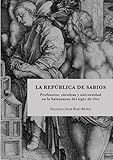La República de sabios. Profesores, cátedras y universidad en la Salamanca del siglo de Oro
Material type: ArticleLanguage: Spanish Publication details: Universidad Carlos III de Madrid. Figuerola Institute of Social Science History 2020Description: 1 electronic resource (289 p.)ISBN:
ArticleLanguage: Spanish Publication details: Universidad Carlos III de Madrid. Figuerola Institute of Social Science History 2020Description: 1 electronic resource (289 p.)ISBN: - 9788413246246
| Item type | Home library | Collection | Call number | Materials specified | Status | Date due | Barcode | |
|---|---|---|---|---|---|---|---|---|
 Electronic-Books
Electronic-Books
|
OPJGU Sonepat- Campus | E-Books Open Access | Available |
Open Access star Unrestricted online access
In the year 1606, Gil González Dávila published one of the first books about the History of Salamanca. He spoke of the University as the "Republic of the wise men", a metaphor that described the importance of professors at that time. Precisely 'The Republic of Sages. Professors, Chairs and University in the Salamanca of Golden Age' is a monography that aims to draw the ins and outs of a group of intellectuals, the university professors, whose teaching life was developed at the time of greatest splendor of the Studio Salmanticensis. It is paradoxical that, despite having nurtured the international and timeless fame of the University of Salamanca, its faculty lacked a group study like the one now presented. Through historical research based on different sources and a double prosopographic and socioeconomic approach, the generation of professors between 1570 and 1600 is analyzed, although their projections are extended to other peninsular spaces and to a wider chronology, the reigns of Philipp II (1556-1598) and Philipp III (1598-1621). In short, this book seeks to explain the professor guild during the golden stage of the University of Salamanca, which, as alma mater, hosted and educated their children by providing the umbrella of a thriving institution. But, as in all families, relationships were not always harmonious; after all, although common features predominate, the stems are always different. In this sense, the faculty the University of Salamanca appears as a heterogeneous group that, however, is defined by its high academic background; a true "republic of wise men" whose diffuse voice in the past begins to be understood now.---En el año 1606, Gil González Dávila publicaba una de las primeras Historias de la ciudad de Salamanca. En ella hablaba de la Universidad como la "República de sabios", una metáfora que describía la importancia del profesorado en ese momento. Precisamente La República de sabios. Profesores, cátedras y universidad en la Salamanca del siglo de Oro es una obra que pretende sacar los entresijos de un grupo de intelectuales, los profesores universitarios, cuyo desempeño docente se desarrolló en el momento de mayor esplendor del Estudio Salmantino. Resulta paradójico que, a pesar de haber nutrido la fama internacional y atemporal de la Universidad de Salamanca, su profesorado careciera de un estudio de grupo como el que ahora se presenta. A través de la investigación histórica basada en diferentes fuentes y un doble enfoque prosopográfico y socioeconómico, se analiza la generación de catedráticos entre 1570 y 1600, si bien sus proyecciones se amplían hacia otros espacios peninsulares y hacia una cronología más amplia, los reinados de Felipe II (1556-1598) y Felipe III (1598-1621). En definitiva, este libro pretende dar cuenta del gremio docente durante la etapa áurea de la Universidad de Salamanca, la cual, como alma mater, acogió y educó a sus hijos proporcionándoles el paraguas de una institución pujante. Pero, como en todas las familias, las relaciones no siempre eran armónicas; al fin y al cabo, aunque predominen unos rasgos comunes, los vástagos siempre son diferentes entre sí. En este sentido, el profesorado aparece como un grupo heterogéneo que, sin embargo, se define por su elevada formación académica; una verdadera "república de sabios" cuya voz difusa en otro tiempo comienza a entenderse ahora.
Creative Commons https://creativecommons.org/licenses/by-nc-nd/4.0/ cc https://creativecommons.org/licenses/by-nc-nd/4.0/
Spanish
There are no comments on this title.

